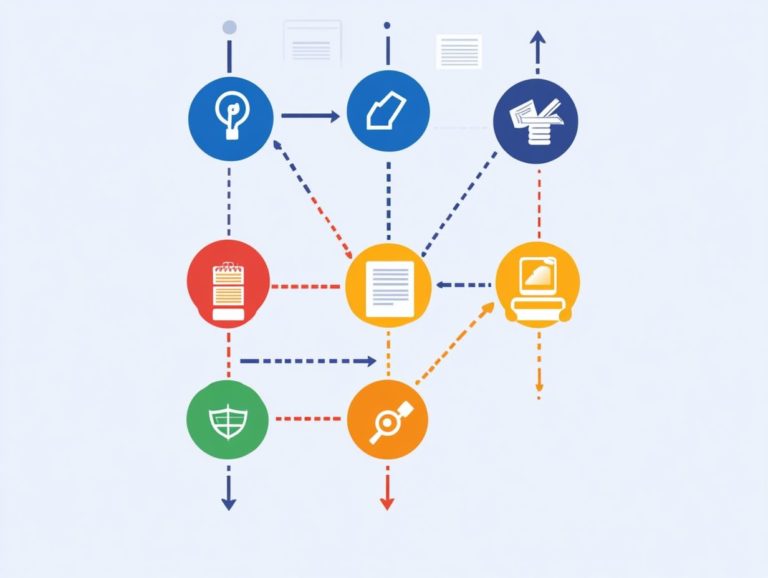Top 5 Project Management Methodologies to Learn
In today s fast-paced business landscape, choosing the right project management methodology can profoundly impact the success of your projects.
Let s dive into the top five project management methodologies: Agile, Waterfall, Scrum, Lean, and Kanban. Each methodology brings distinct strengths and challenges. This guide highlights their key differences, potential benefits, and drawbacks, giving you a comprehensive overview.
You will also discover how to implement these methodologies across various industries and explore emerging trends that could influence the future of project management. Whether you re a seasoned project manager or just starting your journey, this knowledge will empower you right away!
Contents
- Key Takeaways:
- 1. Agile Methodology
- 2. Waterfall Methodology
- Conclusion
- 3. Scrum Methodology
- 4. Lean Methodology
- 5. Kanban Methodology
- Which Project Management Methodology Is Right for You?
- What Are the Key Differences Between These Methodologies?
- How Can These Methodologies Benefit Project Teams?
- What Are the Potential Drawbacks of Each Methodology?
- How Can These Methodologies Be Implemented in Different Industries?
- What Are the Future Trends and Developments in Project Management Methodologies?
- Frequently Asked Questions
Key Takeaways:

Agile methodology focuses on flexibility and adaptability, making it ideal for fast-paced and constantly changing projects.
Waterfall methodology follows a sequential, linear approach, making it best suited for projects with well-defined requirements and a fixed timeline.
Scrum methodology emphasizes teamwork and collaboration, making it suitable for complex projects with a high level of communication and coordination.
1. Agile Methodology
Agile methodology is a dynamic project management approach that prioritizes flexibility and collaboration. It is exceptionally suited for environments where rapid digital change and adaptability are paramount.
By focusing on small, repeatable steps, Agile promotes continuous improvement and ensures effective stakeholder engagement throughout the project lifecycle. This ultimately leads to superior business outcomes.
The Scrum model encourages you and your team to break work into manageable sprints. Regular ceremonies like daily stand-ups, sprint reviews, and retrospectives foster open communication, allowing team members and stakeholders to share insights and adjust priorities.
The roles within Scrum, such as the Scrum Master and Product Owner, facilitate collaboration and ensure that user input is consistently woven into product iterations.
By actively involving stakeholders in discussions about project scope and requirements, your team can adapt, pivot, and deliver a product that genuinely meets user needs. This nurtures an environment of trust and continuous refinement.
2. Waterfall Methodology
The Waterfall methodology represents a traditional project management approach, marked by a linear and sequential design process. Each phase must be completed before moving on to the next, making it particularly suitable for projects with clearly defined requirements and deliverables.
Your journey begins with project planning, where you outline objectives and scopes. Next, you gather requirements, emphasizing the crucial task of thoroughly understanding and documenting client needs to prevent potential misunderstandings.
After that, the design phase creates detailed specifications to serve as your roadmap during implementation, where coding or product development takes place.
Once your product is developed, it enters a verification phase involving rigorous testing to ensure every requirement has been met satisfactorily. The maintenance phase then provides ongoing support and updates to keep everything running smoothly.
The Waterfall approach excels in managing risks effectively, especially in industries like construction or software development, where timelines are strict and changes can be expensive.
Conclusion
Understanding these project management methodologies is essential for driving success in your projects. By choosing the right approach, you can better navigate challenges and ensure that your team delivers outstanding results.
3. Scrum Methodology
Scrum is an agile project management framework designed to enhance efficiency and help teams work together by breaking work into short, manageable sprints. This allows you to deliver high-quality project outcomes within fixed timelines while maintaining flexibility in the face of change.
With this approach, you can regularly assess your progress and adapt as necessary, which is essential in today s fast-paced environments. Key roles within the framework are critical to its success.
The Scrum Master serves as a facilitator, mentoring your team and ensuring everyone adheres to Scrum practices. Meanwhile, the Product Owner prioritizes tasks based on stakeholder needs and project goals, while the Development Team, composed of skilled professionals, focuses on executing the tasks outlined in each sprint.
Engaging ceremonies like Sprint Planning allow you to define goals and allocate tasks effectively, while the Daily Scrum promotes open communication and transparency. By conducting Sprint Reviews, stakeholders can give feedback, enhancing the final product.
Retrospectives offer opportunities for ongoing improvement in team processes, ultimately boosting overall project visibility and involvement.
4. Lean Methodology

Lean methodology helps you get more value while minimizing waste, making it an essential approach in project management. It s all about achieving efficiency through continuous improvement in processes and resource allocation.
By focusing on eliminating non-value-adding activities, this approach helps you examine your workflows closely. One of the pivotal tools in Lean methodology is value stream mapping. This tool helps you see how your work flows and find areas to improve.
Lean principles have proven their worth across various sectors, from manufacturing and healthcare to software development, enhancing customer satisfaction and driving operational efficiency.
When you compare it to traditional methodologies, Lean often results in quicker project delivery times and fosters better collaboration among team members, ultimately boosting your project success rate.
5. Kanban Methodology
Kanban methodology leverages visual boards to transform your task management and project execution experience. This approach grants you crystal-clear visibility into work progress, enabling you to manage workflow effectively while remaining agile in the face of changing project demands.
With the use of color-coded cards and columns, you can swiftly identify which tasks are in progress, completed, or still pending. This clear view of your work is a game-changer, fostering enhanced communication and collaboration among team members, ensuring that everyone is aligned and informed.
Work-in-progress limits are a cornerstone of Kanban; these limits keep your team focused on completing tasks before starting new ones. The emphasis on continuous delivery within this framework supports a steady flow of work, ultimately boosting your overall productivity.
When you integrate Kanban with methodologies like Agile or Scrum, you can further streamline your processes, optimizing your approach and delivering high-quality results more efficiently. Get started with Kanban now to boost productivity.
Which Project Management Methodology Is Right for You?
Choosing the right project management methodology is vital for achieving your project goals, as it significantly impacts stakeholder feedback, resource management, and your ability to effectively navigate project complexities.
To ensure your selected approach aligns seamlessly with the specific needs of your project, evaluate the unique requirements at hand, such as deadlines, budget constraints, and desired outcomes.
Analyzing team dynamics is also essential; for instance, agile methodologies may be a better fit for teams that thrive on flexibility and rapid iteration, while traditional approaches like Waterfall can shine in environments where strict timelines and regulatory compliance are critical.
Assessing the complexity of your project is key, as it helps you determine the adaptability of various methodologies.
By exploring options like Scrum for iterative development or Kanban for continuous task management, you can identify the best fit that not only meets delivery schedules but also promotes collaboration and aligns with your organizational priorities.
Choosing the right methodology can change your project’s success, so act now to find the best fit!
What Are the Key Differences Between These Methodologies?
Agile, Waterfall, Scrum, Lean, and Kanban are different project management methods. Each has a unique way of handling project scope, teamwork, and change.
Waterfall is structured and follows a clear path, making it best for projects with fixed requirements.
Agile, on the other hand, is flexible. It allows teams to adapt quickly to feedback and changes.
Scrum is a part of Agile, focusing on short work cycles known as sprints and getting constant input from stakeholders.
Lean and Kanban also belong to the Agile family. Lean aims to cut out waste, while Kanban helps visualize work stages to boost efficiency.
By knowing these differences, you can choose the best approach for your project and enhance your team’s success.
How Can These Methodologies Benefit Project Teams?

Each project management method has unique benefits that can help your team. They improve how you engage stakeholders, promote ongoing improvement, and increase project efficiency.
Agile methods help you adjust to changes and encourage teamwork, which is perfect for fast-paced fields like software development.
Waterfall provides a structured approach, ideal for industries like construction that require detailed planning.
Lean focuses on reducing waste and adding value, making it a great fit for manufacturing sectors that prioritize efficiency.
These methodologies help your team align with company goals and adapt to different industry needs, leading to successful projects and happy stakeholders.
What Are the Potential Drawbacks of Each Methodology?
Every project management method has its strengths and weaknesses. Recognizing these drawbacks is essential for effective application.
Agile can sometimes feel disorganized due to its flexibility, especially in larger projects that need documentation.
Waterfall’s strictness can be a challenge in fast-changing environments that require adaptability.
While Scrum helps maintain focus, the intense sprint cycles can lead to team burnout.
Lean can overlook important details when trying to eliminate waste. Kanban’s visual approach can become overwhelming if not managed properly, causing delays.
To handle these issues, consider using a mix of methods and hold regular check-ins. This ensures your approach fits your project while keeping quality high and your team supported.
How Can These Methodologies Be Implemented in Different Industries?
Project management methodologies vary across industries such as software development, manufacturing, and IT. Each has unique requirements and challenges.
Agile methodologies excel in dynamic environments. They allow flexibility to adapt projects in real-time based on customer feedback.
In construction or manufacturing, the Waterfall model is often preferred. This structured approach minimizes risks in large-scale projects.
Scrum is powerful in tech, helping teams respond swiftly to changing client needs through iterative progress and collaboration.
Lean principles focus on efficiency and waste reduction, transforming operations in sectors like healthcare. Kanban improves workflow visualization in retail.
Exploring these adaptations showcases their versatility and highlights success stories where companies achieved remarkable results.
What Are the Future Trends and Developments in Project Management Methodologies?
Emerging trends in project management methodologies, especially the rise of hybrid approaches, are transforming how organizations respond to digital change.
This evolution reflects the necessity for flexibility in a rapidly changing business landscape, allowing a blend of Agile, Waterfall, and other frameworks.
By integrating both traditional and modern practices, you can align project outcomes with specific business goals while remaining adaptable to technological advancements.
As technology influences project delivery, fostering collaborative environments is essential to make the most of data analytics and remote working tools.
This keeps teams agile and responsive to changes. Get ready! These hybrid approaches are set to revolutionize project management.
Frequently Asked Questions

What are the top 5 project management methodologies to learn?
The top five project management methodologies to learn are Agile, Scrum, Waterfall, Lean, and Six Sigma.
What is Agile project management?
Agile project management is an iterative approach focusing on flexibility, collaboration, and continuous improvement.
What is Scrum project management?
Scrum is a framework that delivers small, incremental pieces of a project while adapting to changes and feedback from stakeholders.
What is Waterfall project management?
Waterfall project management follows a linear approach that progresses sequentially, with each phase building upon the previous one.
What is Lean project management?
Lean project management focuses on eliminating waste, improving efficiency, and continuously delivering value to customers.
What is Six Sigma project management?
Six Sigma is a data-driven approach that aims to minimize defects and variations in a process to enhance quality and efficiency.
Interested in implementing these methodologies? Learn more about how they can transform your projects.






